Gender and Inclusion
Gender, age, abilities and other individual or context-specific characteristics present different opportunities and challenges to provide CVA to people in crisis in a dignified manner.
Among humanitarian actors, there is an increasing acknowledgement of the specific needs and constraints of people of differing abilities, older people, people of different genders, particularly women, and people on the move. Alongside this is a growing appreciation of the need for tailored and sensitive measures that ensure their effective inclusion.
Supporting the needs of diverse people with CVA goes beyond making them a target group; it is about meaningful engagement, purposive design and implementation, and programme adjustment to meet different groups’ needs with dignity. Inclusive approaches go hand in hand with people-centred aid.
Current priorities
The CALP Network will continue to encourage cash actors to widen their focus to be more inclusive and champion a fuller understanding of how CVA can go beyond the notion of ‘do no harm’ towards appropriately addressing the needs of diverse people in safe and dignified manners.
We will work to elevate the experiences and initiatives on CVA and gender, disability inclusive CVA, working with different ethnicities and cultural identities, minority groups, people with diverse sexual identities, and age groups.
CALP will also strive to make its work as accessible as possible.
Featured content

Collected Papers on Gender and Cash Transfer Programmes in Humanitarian Contexts
Report
Existing gender inequalities mean that disasters and conflicts impact women, men, girls and boys differently. Cash based assistance is one of the most significant developments in humanitarian assistance in recent years. But the relationship between gender and cash based assistance in humanitarian contexts is poorly understood. All too often, interventions are designed based on assumptions...

Microlearning video: CVA and Gender
Blog Post
This video provides an overview of the relationship between gender and cash and voucher assistance (CVA) structured around the humanitarian project cycle, which include: Assessment and response analysis: How to adjust the assessment processes to achieve a more accurate reflection of gender and markets. Design and implementation: How to use methods and protocols to reduce the potential...
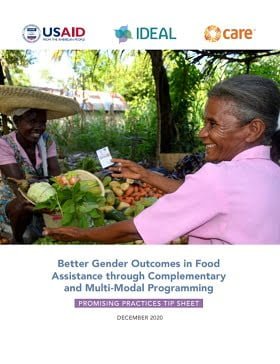
Better Gender Outcomes in Food Assistance through Complementary and Multi-Modal Programing: Promising Practices Tip Sheet
Guidelines and Tools
This Tip Sheet is excerpted from the research report, “Better Gender Outcomes in Food Assistance through Complementary and Multi-Modal programming,” and gives promising practices by the cycles of project cycle management, as well as at the response level. Additionally, there are expert tips and wisdom practices that support the use of a gendered approach in development or humanitarian...

Cash & Voucher Assistance and Gender-Based Violence Compendium
Guidelines and Tools
The Compendium is intended as a companion to the 2015 Inter-Agency Standing Committee (IASC) Guidelines for Integrating Gender-Based Violence Interventions in Humanitarian Action and its companion resource, the GBV Pocket Guide. The guidance was developed through the efforts of 15 organizations who contributed expertise in the inception, design and review of the document. The process was led...
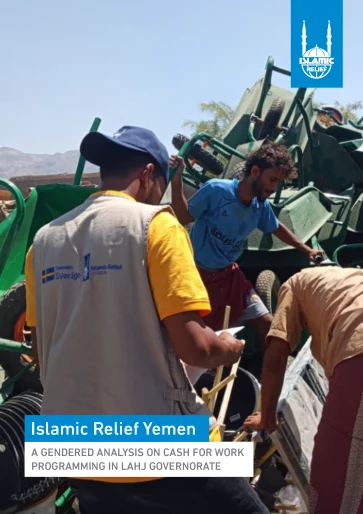
A Gendered Analysis on Cash for Work Programming in Lahj Governorate
Case Study
Cash for Work (CFW) programmes are designed to help the most vulnerable people meet their essential and basic needs. In Yemen, CFW interventions are responding to an ever-growing proportion of the Yemeni population that are in need of humanitarian assistance. Working with communities in the targeted areas of Hudayda and Lahj, the Swedish International Development Cooperation Agency SIDA-funded...
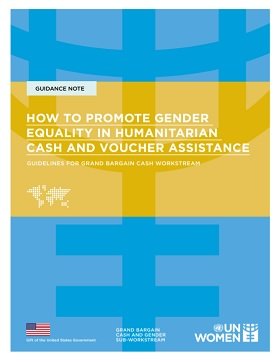
How to Promote Gender Equality in Humanitarian Cash and Voucher Assistance
Guidelines and Tools
The use of cash and voucher assistance (CVA) in humanitarian action is increasing rapidly.
With this rise, there is also growing demand by stakeholders to ensure CVA is more gender-responsive, addressing gender gaps and moving towards greater gender equality.
Gender-responsive CVA, which recognizes existing disparities and addresses the needs of all crisis-affected people equally, has the...
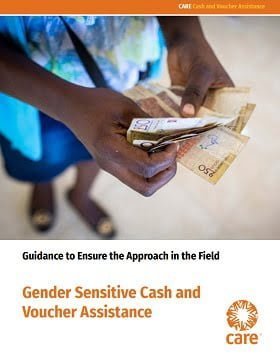
Gender-Sensitive Cash and Voucher Assistance: Guidance to ensure the approach in the field
Guidelines and Tools
This guidance builds on CARE’s ambition-via practice, research, evidence on CVA–and aims to support the application of gender sensitive CVA throughout the project cycle and at the response level. It is divided into two sections: – Part A: ‘What has been learned about gender sensitive CVA?,’ briefly explains the recommendations that came from the research. – Part B: ‘How do we...

Enablers and Gaps: Gender Equality, Gender-Based Violence Response and Mitigation in Cash and Voucher Assistance at Response levels: analysis on three case studies
Report
The Gender and Cash Sub-Workstream identified three case studies that illustrate how Cash Working Groups, GBV Sub-Clusters, gender focal points (e.g. Gender in Humanitarian Action Working groups at country and regional level) and humanitarian partnerships can enable meaningful and wider engagement on gender equity and GBV response in CVA. The case studies all show different aspects of linking...

How to mitigate gender-based violence (GBV) risks in cash and voucher assistance (CVA)
Video
Cash and voucher assistance (CVA) is an important tool to help individuals affected by crises get back on their feet. But just like any other form of assistance, it is vital to ensure that it does not fuel tensions in the household or in the community and that it does not create new risks for women and girls. Fortunately, there are a variety of ways that cash actors can work to mitigate risks...

Inclusive Information Systems for Social Protection: Intentionally Integrating Gender and Disability
Policy paper
Digital information systems serving the social protection sector, and especially social assistance, are increasingly prominent and will continue to be, as is the case within all other sectors. “Why? Because the ability of a country to care for its people and respond to their lifecycle needs depends on its ability to identify those who are in need, enroll them, provide tailored benefits and...
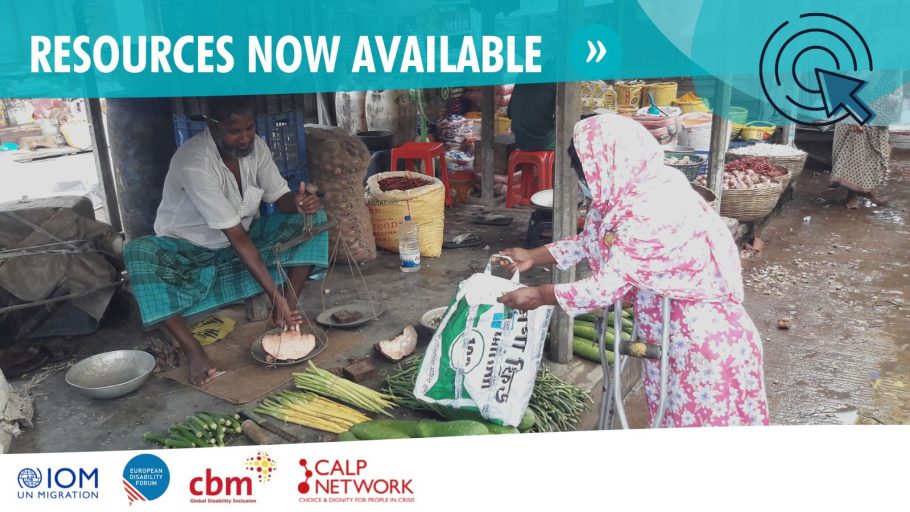
Mainstreaming disability inclusion into humanitarian CVA
Presentation
What is a rights-based approach to disability? How can disability inclusion be mainstreamed to ensure more inclusive and effective CVA humanitarian responses? To answer these key questions, CALP, CBM Global, European Disability Forum and International Organization for Migration (IOM), came together to organize the webinar “Mainstreaming disability inclusion into humanitarian CVA”, with the...
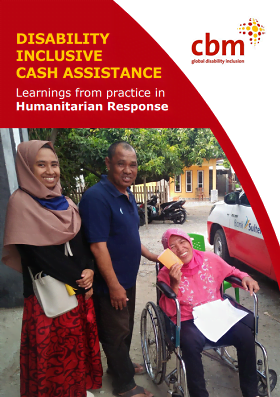
Disability Inclusive Cash Assistance: Learnings from Practice in Humanitarian Response
Guidelines and Tools
This case study collection describes lessons learned from seven inclusive humanitarian cash transfer projects implemented from 2015 – 2020 in Niger, Zimbabwe, Pakistan, Bangladesh, Philippines, and Indonesia, and five ongoing projects from the 2020 Covid-19 pandemic responses. This good practice collection aims to benefit both humanitarian practitioners engaged in Cash Based Interventions...
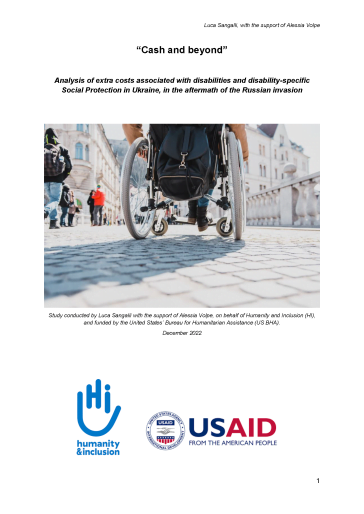
Cash and beyond – Analysis of extra costs associated with disabilities and disability-specific social protection in Ukraine, in the aftermath of the Russian invasion
Report
Following the escalation of the conflict in Ukraine in February 2022 and the consequent humanitarian crisis, the country has experienced active fighting and massive displacement, both within and outside its borders. Persons with disabilities and older persons have been facing particularly harsh effects, especially for those with more severe forms of disabilities, who encountered challenges in...
Thematic lead
Latest

Inclusive Information Systems for Social Protection: Intentionally Integrating Gender and Disability
Policy paper
Digital information systems serving the social protection sector, and especially social assistance, are increasingly prominent and will continue to be, as is the case within all other sectors. “Why? Because the ability of a country to care for its people and respond to their lifecycle needs depends on...
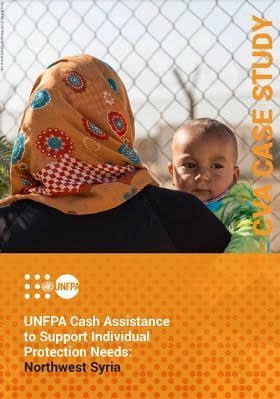
UNFPA Cash Assistance to Support Individual Protection Needs in Northwest Syria
Report
As part of humanitarian programming in northwest Syria, through cross-border operations managed from Turkey, UNFPA provided one-off, unconditional, Individual Protection Assistance (IPA) in the form of cash disbursements to 10,074 vulnerable Internally Displaced Persons (IDPs) to cover the costs of their...

2020 Cash and Voucher Programming (CVP): Roadmap and milestone achieved
Report
In 2020, World Vision has implemented cash and voucher programming like never before – not least due to the COVID-19 pandemic and related social protection transfer scale-ups. From 2019 to 2020, we have seen a 28 % increase of our cash, voucher based programming, moving towards enabling affected...
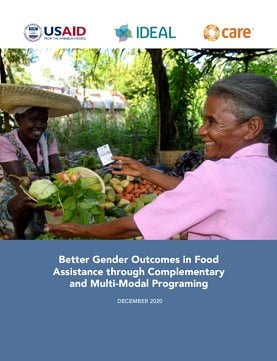
Better Gender Outcomes in Food Assistance through Complementary and Multi-Modal Programing
Report
There is now widespread recognition and evidence that CVA can have highly positive socio-economic impacts, ranging from poverty reduction and improved living conditions to enhanced psychosocial well-being. Despite such steps toward food assistance programming that fosters dignity and choice and stimulates...

Better Gender Outcomes in Food Assistance through Complementary and Multi-Modal Programing: Promising Practices Tip Sheet
Guidelines and Tools
This Tip Sheet is excerpted from the research report, “Better Gender Outcomes in Food Assistance through Complementary and Multi-Modal programming,” and gives promising practices by the cycles of project cycle management, as well as at the response level. Additionally, there are expert tips and wisdom...

Cash Transfers and Women’s Economic Inclusion: Experimental evidence from Zambia
Case Study
This paper investigates whether an increase in exogenous income through the Child Grants model of the Social Cash Transfer programme in Zambia fosters economic inclusion among rural women. We conceptualize economic inclusion as a transformative process comprised of four pillars: productive capacity,...

Cash and Voucher Assistance Guidelines for Lao PDR
Guidelines and Tools
Cash and voucher assistance is becoming increasingly popular in Lao PDR in delivering humanitarian assistance, rehabilitation and development focused projects. In supporting the cash and voucher assistance agenda in Lao PDR, the Cash Working Group was established as a working group for local and regional...

Cash transfer and child protection: An integrated approach to address the needs of unaccompanied and separated adolescents in the Central African Republic
Report
This report assesses Plan International’s Monetary Transfer and Child Protection Project in Central African Republic. It aims to understand the strengths and weaknesses of the programme, including implementation challenges and successes, benefits and associated risks for beneficiaries,and to identify...
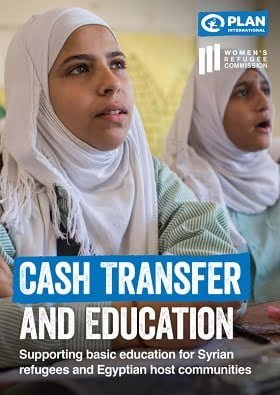
Cash Transfer and Education: Supporting basic education for Syrian refugees and Egyptian host communities
Report
This report assesses Plan International’s Tawasol: Learning for Coexistence Project in Egypt to understand its strengths and weaknesses, including implementation challenges and successes, risks and benefits for beneficiaries, and any needs for continued capacity building. Plan International – with...
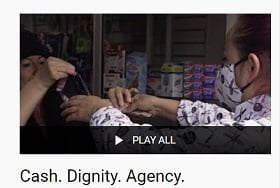
Cash. Dignity. Agency.
Video
Watch the videos here Displaced people face higher rates of gender-based violence before, during, and after they are forced to move. The Women’s Refugee Commission (WRC) explores how cash transfers can be used in response to gender-based violence and its potential to help displaced persons, including...
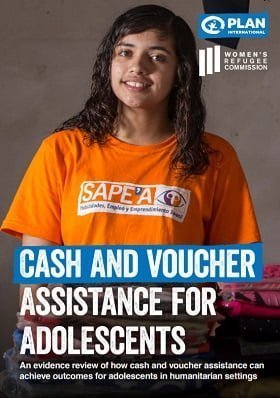
Cash and Voucher Assistance for Adolescents: An evidence review of how cash and voucher assistance can achieve outcomes for adolescents in humanitarian settings
Report
During crises, the institutions, systems and community cohesion that normally support adolescent development break down. Humanitarian response often fails to take the necessary steps to mitigate and counteract the disadvantages that adolescent girls and boys in crisis face – including access to...

Cash and Voucher Assistance, Gender Equality and Gender-Based Violence Integration in Humanitarian Response Plans: Venezuelan Refugees and Migrants Case Study
Report
The case study was created with the inputs of the Regional Cash Working Group, supported by CashCap, and UNWOMEN’s regional gender focal point in the Response for Venezuelans. It demonstrates an example of meaningfully integrating gender and cash and voucher assistance at a response level. In October...

Establishing a Cash Working Group and GBV Sub-Cluster task force: NW Syria Case Study
Report
The case study was created with the inputs of two Cash Working Group leads and the GBV Turkey cross-border Sub-Cluster leads in the Northwest Syria response. The case study demonstrates an example of meaningful linking of gender-based violence response and cash and voucher assistance. As Cash and Voucher...

Gender Equality and Gender-Based Violence Risk Mitigation in Cash and Voucher Assistance: Vanuatu Case study
Report
The case study was created with the inputs of Oxfam Vanuatu and UNFPA Vanuatu. It demonstrates the meaningful connection of cash and voucher assistance and gender at a response level. Vanuatu is one of the world’s most remote locations and particularly vulnerable to cyclones and other natural hazards....

Gender Equality and Cash and Voucher Assistance: Tools and guidance
Guidelines and Tools
With the continuous uptake and scaling of cash and voucher assistance (CVA), it is more critical than ever that humanitarian and development actors shift their focus away from measuring gender mainstreaming and gender equality efforts by metrics (e.g. targeting at least 50% women), towards strategically...

Gender Based Violence and Cash and Voucher Assistance: Tools and guidance
Guidelines and Tools
There is increasing momentum among Gender-Based Violence (GBV) and Cash and Voucher Assistance (CVA) actors in the humanitarian sector to consider linkages between GBV and CVA in all CVA projects at all stages of the project cycle.
Integrating gender and CVA was set as a priority action under the Grand...

CVA: Your Role as a GBV Coordinator (UNFPA / GBV AoR)
Guidelines and Tools
UNFPA’s Humanitarian Office and the GBV Area of Responsibility have developed this guidance on “CVA – Your Role as a GBV Coordinator,” for GBV coordination group leads and partners in humanitarian settings. Its purpose is to outline the practical ways in which GBV Coordinators should support GBV-...
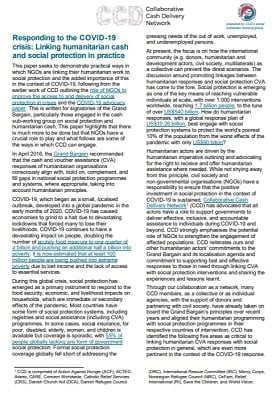
Responding to the COVID-19 Crisis: Linking humanitarian Cash and Social Protection in practise
Report
This paper seeks to demonstrate practical ways in which NGOs are linking their humanitarian work to social protection and the added importance of this in the context of COVID-19, following from the earlier work of CCD outlining the role of NGOs to
improve the access to and delivery of social protection in...

CVA and GBV webinar series for gender and cash subworkstream 2020
Webinar recording
Cash and voucher assistance (CVA) is now a common tool in humanitarian action used to meet the diverse needs of those displaced by crisis and conflict, and it is on the rise. Despite a push by several humanitarian actors since 2015, its use for protection outcomes – including to support the prevention...

Presentation for the CALP Network’s webinar on remote registration and verification in the COVID-19 response
Presentation
Watch the webinar recording here Speaker presentations from the CALP Network’s 14 July 2020 webinar on: Peril or pitfalls?: Emerging practices on remote registration and verification in the COVID-19 response Remote CVA programming has been highlighted as a key challenge for the community of practice in...



